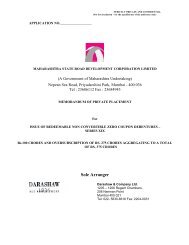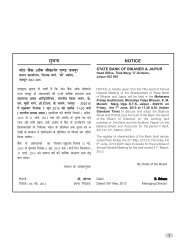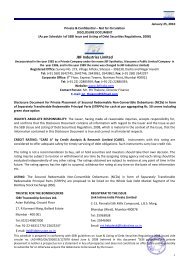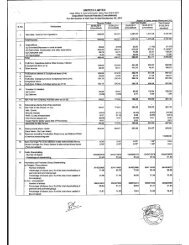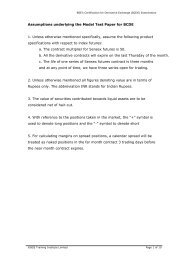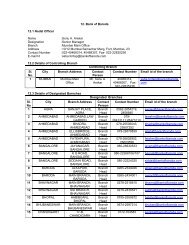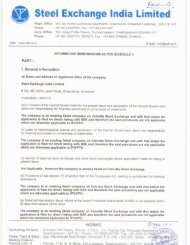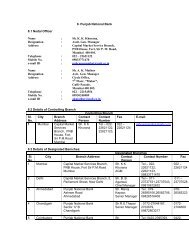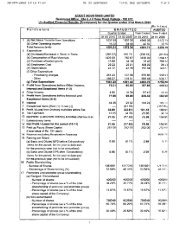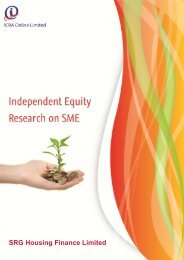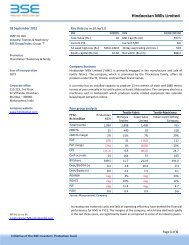EXCEL CROP CARE LIMITED C O N T E N T S - BSE
EXCEL CROP CARE LIMITED C O N T E N T S - BSE
EXCEL CROP CARE LIMITED C O N T E N T S - BSE
You also want an ePaper? Increase the reach of your titles
YUMPU automatically turns print PDFs into web optimized ePapers that Google loves.
<strong>EXCEL</strong> <strong>CROP</strong> <strong>CARE</strong> <strong>LIMITED</strong><br />
SCHEDULE FORMING PART OF THE BALANCE SHEET AND THE PROFIT AND LOSS ACCOUNT<br />
SCHEDULE ‘T’<br />
NOTES TO ACCOUNTS<br />
1. NATURE OF OPERATIONS:<br />
Excel Crop Care Limited is engaged in the business of agro chemicals and manufactures technical grade pesticides and formulations. The Company also<br />
manufactures and markets other agri inputs like soil enrichers, bio-pesticides, plant growth regulators and soil and plant nutrition products. The Company has<br />
presence in both the domestic and international markets.<br />
2. SIGNIFICANT ACCOUNTING POLICIES:<br />
(a) Basis of Preparation:<br />
The financial statements have been prepared to comply in all material respects with the Notified Accounting Standards by Companies (Accounting<br />
Standards) Rules, 2006 (as amended) and the relevant provisions of the Companies Act, 1956. The financial statements have been prepared under<br />
the historical cost convention on an accrual basis except in case of assets for which provision for impairment is made. The accounting policies have<br />
been consistently applied by the Company and are consistent with those used in the previous year.<br />
(b) Use of estimates:<br />
The preparation of financial statements in conformity with generally accepted accounting principles requires management to make estimates and<br />
assumptions that affect the reported amounts of assets and liabilities and disclosure of contingent liabilities at the date of the financial statements and<br />
the results of operations during the reporting period. Although these estimates are based upon management’s best knowledge of current events and<br />
actions, actual results could differ from these estimates.<br />
(c) Fixed Assets:<br />
Fixed assets are stated at cost less accumulated depreciation and impairment losses, if any. Cost comprises the purchase price and any attributable<br />
cost of bringing the asset to its working condition for its intended use. Borrowing costs relating to acquisition of fixed assets which takes substantial<br />
period of time to get ready for its intended use are also included to the extent they relate to the period till such assets are ready to be put to use.<br />
(d) Depreciation:<br />
(i) In respect of Buildings, Plant and Machinery and Electrical Installations, on straight line basis in accordance with Section 205(2)(b) of the<br />
Companies Act, 1956, at the straight line rates specified in Schedule XIV to the Companies Act, 1956, except for certain items of Plant and<br />
Machinery, rate of 10% on straight line basis has been applied in place of 5.28% specified in Schedule XIV.<br />
(ii) Leasehold Improvements are depreciated on straight line basis over the lease period.<br />
(iii) In respect of additions to/deletions from the Fixed Assets, on pro-rata basis with reference to the date of addition/deletion of the assets except<br />
for assets costing ` 5,000 or less which have been fully depreciated.<br />
(iv) In respect of all other Fixed Assets, on written down value basis in accordance with Section 205(2)(a) of the Companies Act, 1956, at the rates<br />
specified in Schedule XIV to the Companies Act, 1956.<br />
(e) Impairment:<br />
(i) The carrying amounts of assets are reviewed for impairment at each balance sheet date if there is any indication of impairment based on internal/external<br />
factors. An impairment loss is recognised wherever the carrying amount of an asset exceeds its recoverable amount. The recoverable amount is the<br />
greater of the asset’s net selling price and value in use. In assessing value in use, the estimated future cash flows are discounted to their present value<br />
using a pre-tax discount rate that reflects current market assessments of the time value of money and risks specific to the asset.<br />
(ii) After impairment, depreciation is provided on the revised carrying amount of the asset over its remaining useful life.<br />
(iii) A previously recognised impairment loss is increased or reversed depending on changes in circumstances. However the carrying value after<br />
reversal is not increased beyond the carrying value that would have prevailed by charging usual depreciation if there was no impairment.<br />
(f) Intangible Assets and Amortisation:<br />
(i) Intangible assets are stated at cost less accumulated amortisation.<br />
(ii) Amortisation:<br />
Data Registration expenses (including registration fees) are amortised on a straight line basis over a period of three years and computer<br />
software/licence fees and data compensation charges are amortised on a straight line basis over a period of four years.<br />
(iii) Research and Development Costs:<br />
Research costs (other than cost of Fixed Assets acquired) are charged as an expense in the year in which they are incurred and are reflected under<br />
the appropriate heads of accounts. Development expenditure incurred on an individual project is carried forward when its future recoverability<br />
can reasonably be regarded as assured. Any expenditure carried forward is amortised over the period of expected future sales from the related<br />
project, not exceeding ten years.<br />
The carrying value of development costs is reviewed for impairment annually when the asset is not yet in use, and otherwise when events or<br />
changes in circumstances indicate that the carrying value may not be recoverable.<br />
(g) Leased Assets:<br />
Leases where the lessor effectively retains substantially all the risks and benefits of ownership of the leased term, are classified as operating leases.<br />
Operating lease payments are recognised as an expense in the Profit and Loss Account on a straight-line basis over the lease term. Lease income is<br />
recognised in the Profit and Loss Account on an accrual basis.<br />
(h) Government Grants and Subsidies:<br />
When the grant or subsidy relates to an expense item, it is recognised as income over the periods necessary to match them on a systematic basis to the costs,<br />
which it is intended to compensate. Where the grant or subsidy relates to an asset, its value is deducted in arriving at the carrying amount of the related asset.<br />
(i) Investments:<br />
Investments that are readily realisable and intended to be held for not more than a year are classified as current investments. All other investments<br />
are classified as long-term investments. Current investments are carried at lower of cost and fair value determined on an individual investment basis.<br />
45



